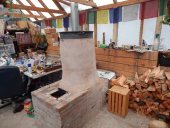
 5
5




“It’s said war—war never changes. Men do, through the roads they walk. And this road—has reached its end.”
 5
5




 2
2




The holy trinity of wholesomeness: Fred Rogers - be kind to others; Steve Irwin - be kind to animals; Bob Ross - be kind to yourself
 3
3




best regards, Byron

 1
1




Mark Brunnr wrote:I'm curious how much ash gets into the pipe runs due to starting fires with cardboard or paper, compared to starting each fire with a feather stick, where you aren't using any paper. Are your examples including the cleaning of the mass, or was this just from cleaning out the feed area?
“It’s said war—war never changes. Men do, through the roads they walk. And this road—has reached its end.”




 2
2




The holy trinity of wholesomeness: Fred Rogers - be kind to others; Steve Irwin - be kind to animals; Bob Ross - be kind to yourself




Mark Brunnr wrote:It sounds like similar amount of ash per cord, which is expected, the ash should just be the nonburnable minerals in the wood.
 1
1




The holy trinity of wholesomeness: Fred Rogers - be kind to others; Steve Irwin - be kind to animals; Bob Ross - be kind to yourself
 1
1




 1
1




best regards, Byron
 5
5





|
pizza for tiny ad? tiny ad? Did you order a pizza?
The new purple deck of permaculture playing cards
https://www.kickstarter.com/projects/paulwheaton/garden-cards
|





